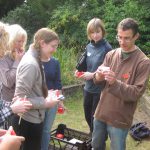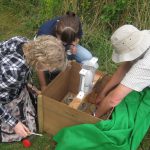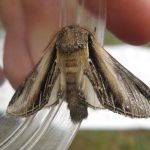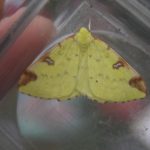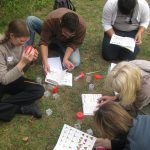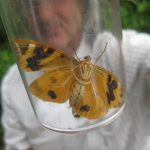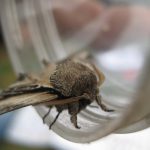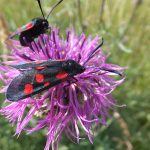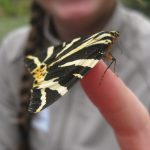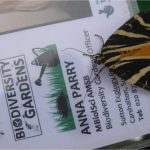The latest in our series of Beginners workshops focused on the ecology and identification of macro moths, which was no easy feat as there are over 2,500 moth species in the UK, 900 of which are macro moths.
We started bright and early to close down the trap and seal in the residents to await identification later that day. Moths are sadly an unpopular species and often met with displeasure or disinterest by the public. They ruin your clothes. Of the 2500+ moths in the UK, only 2 or 3 will harm your clothes and it’s the larvae, not the adult moths, that are the problem. You’ll have nothing to fear with man-made fibres and from the rest of the moth population.
They are dull compared to butterflies. The Jersey Tiger below would care to disagree!

A very friendly Jersey Tiger moth
For our moth workshop we trapped moths using a Skinner trap which is a collapsible wooden box covered with two clear sleeves and a mercury vapour bulb. Gaps below the bulb allow moths to fall down into the box where they can rest beneath a floor of over-turned egg boxes. So, why are moths attracted to light? Why do they fall into the trap? Why do they stay in the trap? No-one knows (in true QI style) but there are plenty of theories out there. Perhaps they mistake the light for the moon, perhaps they just really like empty egg boxes, or perhaps they just like being mysterious. What we do know is that the traps work and provide us with a great means to discover our local species and estimate population numbers.
Moth trapping does not need to be as complicated as this either. You can simply place out a bright light in a garden or park on a white sheet, sit, and wait. Photos are a must for beginners identification but if you’re feeling up to it you can always gather a few in plastic pots and try out the Waring and Townsend excellent Field Guide to the Moths of Great Britain and Ireland. FSC also have a great Guide to the Day-Flying Moths of Britain which you can buy online from various bookstores. If you’re feeling more adventurous you could cook up a brew to tantalise the nectar-loving species that may not be attracted to light traps. A pint of beer mixed with 1kg of brown sugar and 0.5kg treacle will make a lovely sticky feast to paint on fence posts or trees, providing that it’s out of the way of small hands and accidental bumps!
Butterfly Conservation have a number of local groups to get involved with if you are just starting out along with helpful ID tips, and they also coordinate the National Moth Recording Scheme. It is really important to submit and sightings of animals and plants you see to help us build a bigger picture of their status in the UK.
The Moths workshop was lead by Hendryk Jurk, Biodiversity Manager for the London Borough of Sutton, as part of Biodiversity Gardens and funded by the Heritage Lottery. For our next workshop we are joined by David Pinnock from the Bumblebee Conservation Trust to take a look at the world of the bee.
For more information about our upcoming courses visit our events page.
Anna
Biodiversity Gardens Project Officer
- The first moth of the day!
- Inspecting the moth trap.
- Swallow prominent moth wing span
- Brimstone moth
- The tricky task of ID’ing!
- The underside of a Jersey Tiger
- Swallow prominent moth – beautiful!
- We didn’t see this 6-spot Burnet during our workshop but it’s very common in gardens, parks and meadows!
- Try not to handle moths as it can damage their delicate wing scales. This chap wouldn’t leave us alone!
- A very friendly Jersey Tiger moth


